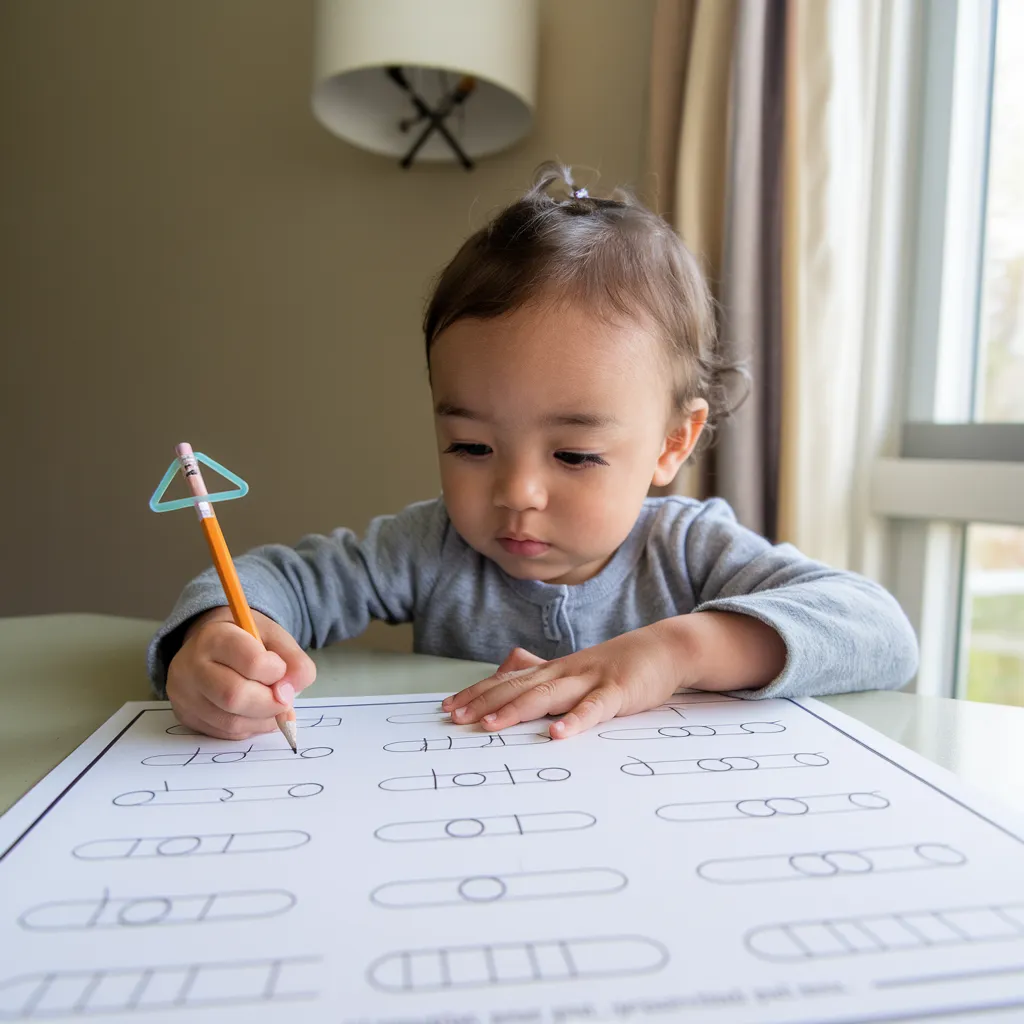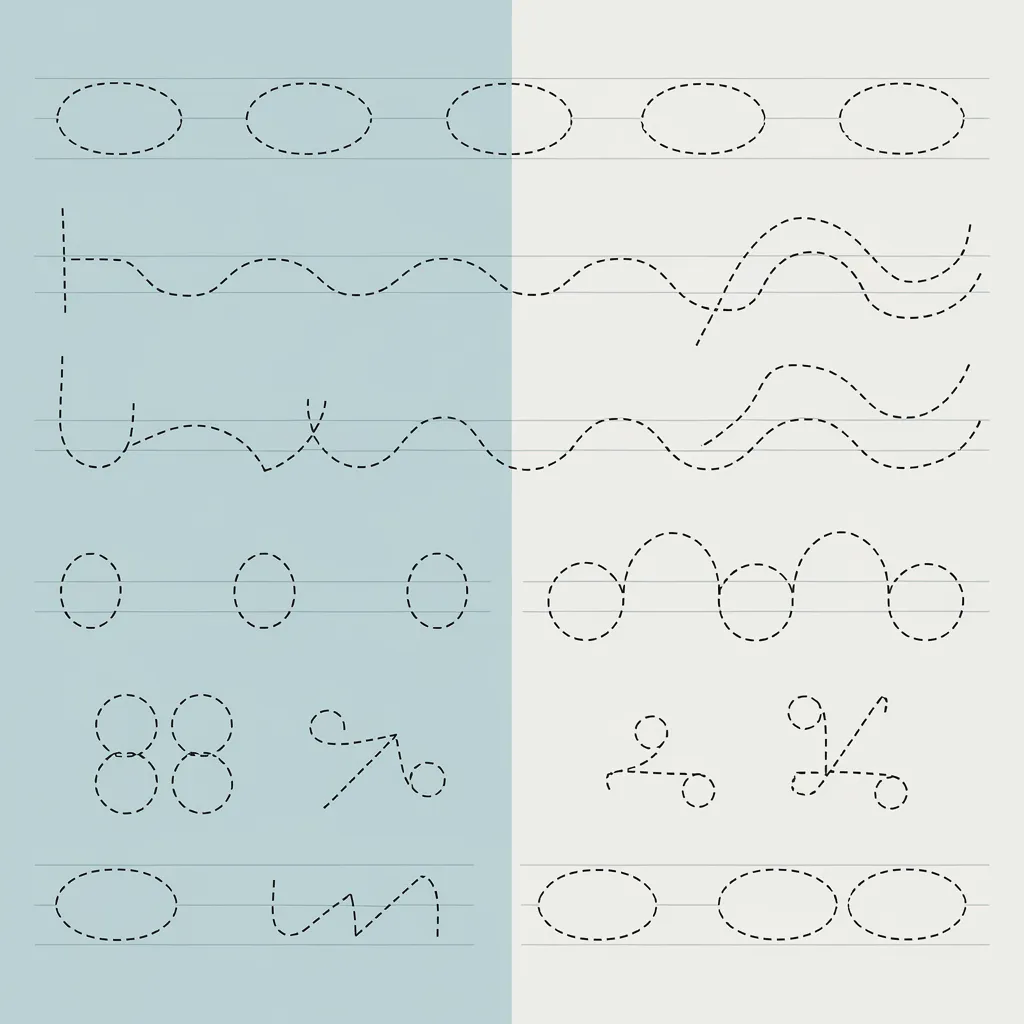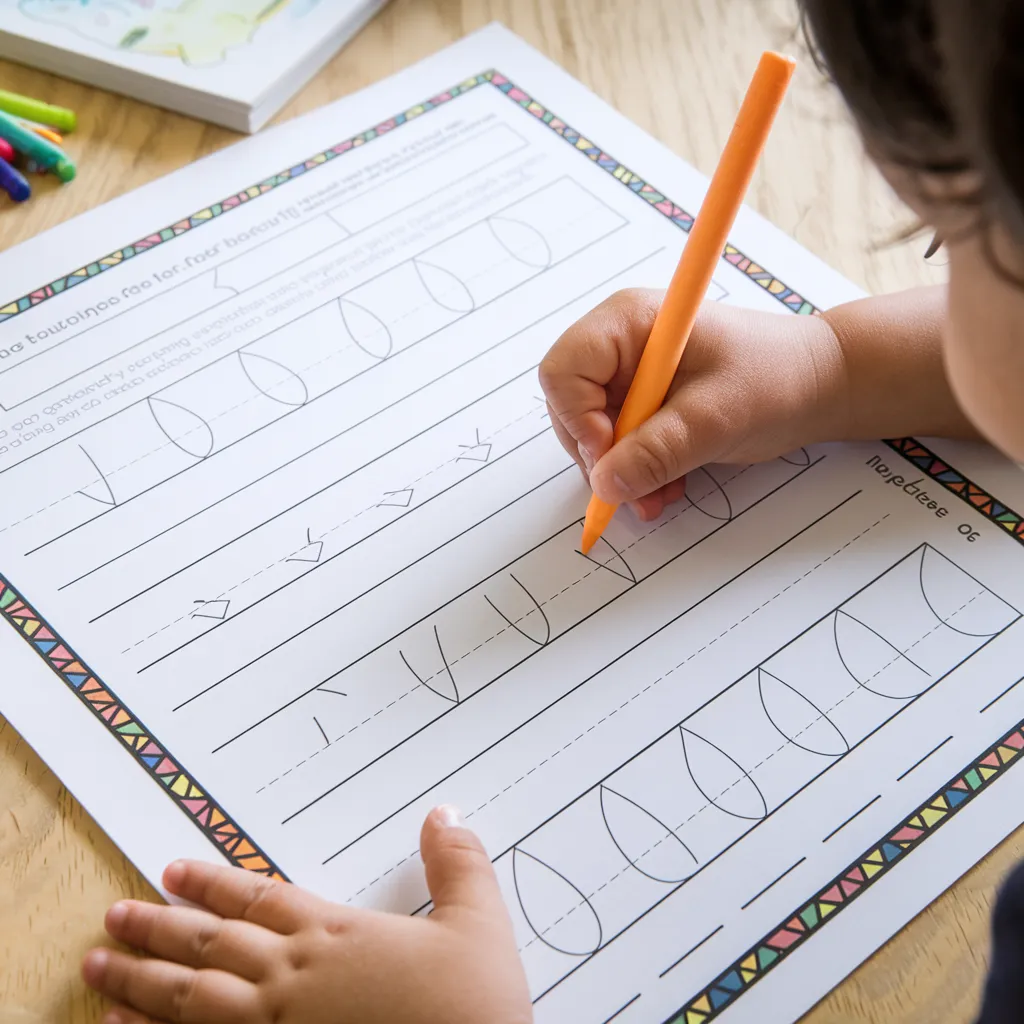Printable prewriting practice provides the crucial foundation children need before they begin formal letter formation and handwriting. These specialized activities—focusing on lines, curves, shapes, and patterns—develop the fine motor control, visual tracking, and cognitive skills necessary for writing success. Whether you’re a preschool teacher planning developmentally appropriate lessons, a kindergarten educator preparing students for handwriting, or a parent supporting early literacy at home, printable prewriting practice offers accessible, structured opportunities to build essential skills. From simple straight line tracing to complex connected patterns, these activities strengthen hand muscles, establish proper pencil grip, and create neural pathways that support future writing fluency. With the right progression of engaging, age-appropriate printable prewriting practice, children gain confidence and competence that prepares them for a lifetime of written communication.

Developmental Benefits of Printable Prewriting Practice
Printable prewriting practice contributes significantly to multiple developmental domains:
Physical Skill Development
- Fine motor control: Strengthening small hand and finger muscles
- Hand-eye coordination: Synchronizing visual input with hand movements
- Proper pencil grip: Establishing efficient, comfortable tool handling
- Writing stamina: Building endurance for extended writing tasks
- Bilateral coordination: Using both hands together effectively
Cognitive Foundations
Printable prewriting practice supports critical mental processes:
- Visual Processing Enhancement
- Developing form recognition and discrimination
- Establishing spatial relationships understanding
- Building visual memory for patterns and strokes
- Strengthening directional tracking (left-to-right, top-to-bottom)
- Improving focused visual attention
- Executive Function Building
- Developing sustained attention for tasks
- Building working memory for stroke sequences
- Establishing planning skills for complex patterns
- Creating self-monitoring of accuracy
- Developing persistence through graduated challenges
- Pre-Literacy Connections
- Recognizing that symbols carry meaning
- Understanding that lines and shapes combine into letters
- Building awareness of writing direction and progression
- Developing understanding of writing as communication
- Creating readiness for letter formation instruction
Types of Printable Prewriting Practice by Skill Progression

Different skill levels require specific types of prewriting activities:
Foundational Printable Prewriting Practice (Ages 2-3)
- Simple Line Tracing
- Horizontal line paths (left to right)
- Vertical line paths (top to bottom)
- Basic dot-to-dot connections
- Wide single-path tracing lanes
- Large format tracing spaces
- Basic Shape Exploration
- Circle tracing and completion
- Simple square outlines
- Triangle basic forms
- Connected shape paths
- Shape size discrimination activities
- Beginning Pattern Awareness
- Simple alternating patterns
- Two-element pattern sequences
- Pattern recognition and extension
- Basic pattern matching activities
- Simple maze paths with minimal turns
Intermediate Printable Prewriting Practice (Ages 3-5)
- Complex Line Combinations
- Diagonal line practice
- Intersecting line patterns
- Connected line sequences
- Zig-zag line formations
- Varying length line combinations
- Curved Line Development
- Basic curved line tracing
- Circle and semicircle combinations
- Wave pattern formations
- Spiral shape practice
- Combined curve and line patterns
- Pattern Complexity Progression
- Multi-element pattern sequences
- Decreasing size pattern series
- Connected pattern strokes
- Pattern completion activities
- Simple letter-like pattern formations
Advanced Printable Prewriting Practice (Ages 4-6)
- Letter-Stroke Foundations
- Vertical-horizontal combinations (t, l, h)
- Circle-line combinations (a, d, g)
- Slanted line patterns (v, w, x)
- Connected curve formations (s, u, j)
- Combined stroke sequences
- Precision Development
- Decreasing path width activities
- Speed-building pattern repetition
- Continuous stroke exercises
- Direction-change mastery
- Writing rhythm development
- Transition to Letter Formation
- Letter-like symbol tracing
- Letter element practice
- Letter family stroke groupings
- Letter component analysis
- Simplified letter forms
Creating Effective Printable Prewriting Practice Materials
Design considerations ensure maximum benefit:

Design Elements for Printable Prewriting Practice
- Visual Clarity Considerations
- High contrast between lines and background
- Appropriate line thickness for developmental stage
- Clear starting points with visual cues
- Uncluttered page designs with focused elements
- Consistent progression across practice sheets
- Engagement Enhancement Features
- Thematic connections to children’s interests
- Character integration for motivation
- Progressive challenge built into designs
- Completion celebration elements
- Visual tracking supports (arrows, numbering)
Customization Approaches for Printable Prewriting Practice
- Difficulty Adjustment Strategies
- Varying line width for different skill levels
- Adjusting support (solid, dotted, starting points only)
- Modifying completion expectations
- Creating repetition opportunities
- Developing physical adaptation options
- Interest-Based Modifications
- Connecting to favorite characters or themes
- Incorporating seasonal elements
- Adapting to curriculum connections
- Creating personalized content
- Developing specific skill-targeted practice
Implementation Strategies for Printable Prewriting Practice
Maximize effectiveness with these practical approaches:
Classroom Integration Methods
- Learning Center Organization
- Creating leveled practice stations
- Developing self-selection systems
- Implementing progress tracking approaches
- Building peer practice opportunities
- Creating teacher assessment checkpoints
- Group Instruction Techniques
- Modeling proper form and technique
- Conducting guided practice sessions
- Implementing partner feedback activities
- Creating collaborative completion projects
- Developing skill-focused mini-lessons
Home Practice Enhancement
- Routine Development
- Establishing consistent practice times
- Creating supportive physical environments
- Implementing progress celebration systems
- Building connection to daily activities
- Developing appropriate practice duration
- Multi-Sensory Extensions
- Creating texture-enhanced tracing surfaces
- Implementing large-motor preparatory activities
- Developing finger-tracing precursors
- Building 3D pattern formation experiences
- Creating sensory-based pattern practice
Troubleshooting Common Challenges with Printable Prewriting Practice

Address typical difficulties with these targeted strategies:
Motivation and Engagement
- Interest-Building Approaches
- Connecting practice to meaningful activities
- Creating game-based practice formats
- Developing success-guaranteed starting points
- Implementing choice within structured options
- Building appropriate challenge progression
- Resistance Management Techniques
- Shortening practice duration initially
- Alternating between favorite and challenging patterns
- Creating movement breaks between attempts
- Developing playful context for practice
- Building connection to child’s interests
Physical Development Support
- Grip Development Assistance
- Implementing proper pencil grip supports
- Creating appropriate writing tool options
- Developing hand strength building activities
- Establishing proper posture and positioning
- Building pre-practice hand warm-ups
- Coordination Challenge Solutions
- Creating stabilized paper systems
- Implementing vertical surface alternatives
- Developing larger-scale practice initially
- Building finger isolation activities
- Creating tracking guide tools
Conclusion
Printable prewriting practice provides the essential foundation for successful handwriting development, building the physical skills, cognitive abilities, and confidence children need before formal letter formation. Through a thoughtful progression from simple lines to complex patterns, these activities create the neural pathways and motor control necessary for writing fluency. Start with developmentally appropriate options that match your child’s current abilities, celebrate small improvements, and gradually increase complexity as skills develop. Remember that consistent, positive practice in short, engaging sessions yields better results than occasional intensive drilling. By implementing engaging, well-designed printable prewriting practice within meaningful contexts, you’ll help children develop not just the mechanical skills for writing but also a positive attitude toward written expression that will serve them throughout their educational journey.
18 Effective Name Tracing Worksheets That Build Essential Early Literacy Skills
Frequently Asked Questions
When should children start using printable prewriting practice?
Most children benefit from informal prewriting experiences around 2-2.5 years old, with more structured printable prewriting practice becoming appropriate between 3-4 years. Look for readiness signs: interest in scribbling and drawing, ability to hold crayons or markers with some control, developing attention span for table activities, and hand dominance emergence. Begin with large-format activities focused on simple horizontal and vertical lines before progressing to more complex patterns. Remember that development varies widely—follow your child’s interest and abilities rather than rigid age expectations. Initial prewriting activities should emphasize exploration rather than precision, with short (3-5 minute) sessions that maintain positive engagement.
How can I tell if printable prewriting practice sheets are appropriate for my child’s developmental level?
Observe your child’s engagement and success rate—appropriate materials should provide just enough challenge to maintain interest without causing frustration. Look for 80-90% success with moderate effort as the optimal learning zone. If you notice grip changes, decreased attention, complaints, or avoidance, the activities likely exceed current capabilities. Conversely, immediate, effortless completion suggests the need for more challenging materials. Physical signs of appropriate difficulty include consistent grip, focused attention, appropriate posture, and engaged expression. Remember that children should progress from wide, heavily supported tracing paths toward narrower, less supported formats as skills develop. The most effective practice balances success with appropriate challenge, building confidence while encouraging growth.
What if my child shows no interest in printable prewriting practice?
First, ensure activities match developmental readiness—resistance often indicates mismatch between skills and expectations. Try alternative formats: vertical surfaces (taped to walls), larger formats, different writing tools (fingerpaints, dot markers), or sensory-based options (tracing in shaving cream, sand trays). Connect practice to interests by incorporating favorite characters or themes. Embed prewriting patterns within meaningful activities like making « roads » for toy cars or « pathways » for figurines rather than presenting them as isolated exercises. Consider timing—children often show more receptiveness during their personal peak alertness periods. Sometimes apparent disinterest actually reflects underdeveloped hand strength or coordination; activities like playdough, tweezers games, and finger plays build these foundational skills without direct prewriting focus.
How long should children spend on printable prewriting practice each day?
Quality matters more than quantity—short, positive sessions yield better results than lengthy, frustrating ones. For young preschoolers (3-4 years), limit focused prewriting activities to 3-5 minutes, potentially once or twice daily. Older preschoolers and kindergarteners (4-6 years) typically manage 5-10 minutes of concentrated practice. Watch for fatigue signals like changing grip, decreased accuracy, or waning attention—these indicate time to conclude or change activities. Consistency is key; brief daily practice is more effective than occasional longer sessions. Integrate prewriting naturally into daily routines and play rather than treating it exclusively as a separate academic exercise. Remember that forced practice often creates resistance, while meaningful, embedded opportunities build positive associations with pre-writing skills.
